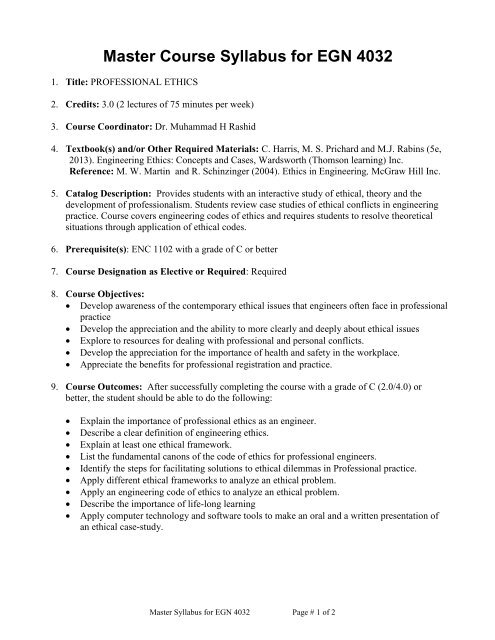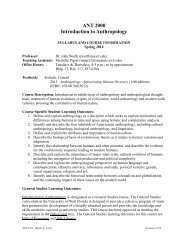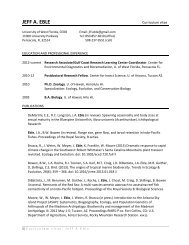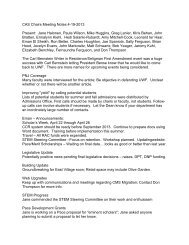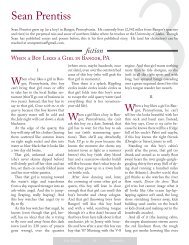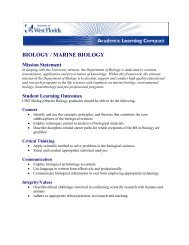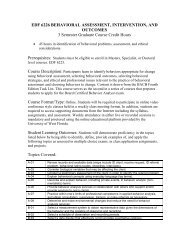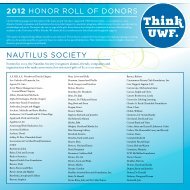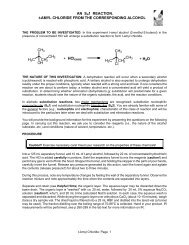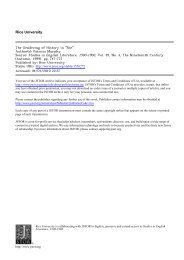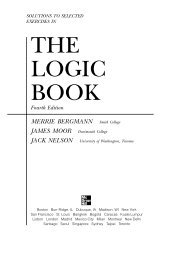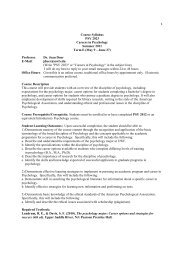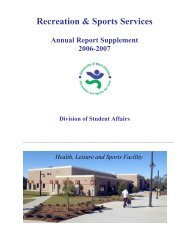Master Course Syllabus for EGN 4032 - University of West Florida
Master Course Syllabus for EGN 4032 - University of West Florida
Master Course Syllabus for EGN 4032 - University of West Florida
You also want an ePaper? Increase the reach of your titles
YUMPU automatically turns print PDFs into web optimized ePapers that Google loves.
<strong>Master</strong> <strong>Course</strong> <strong>Syllabus</strong> <strong>for</strong> <strong>EGN</strong> <strong>4032</strong><br />
1. Title: PROFESSIONAL ETHICS<br />
2. Credits: 3.0 (2 lectures <strong>of</strong> 75 minutes per week)<br />
3. <strong>Course</strong> Coordinator: Dr. Muhammad H Rashid<br />
4. Textbook(s) and/or Other Required Materials: C. Harris, M. S. Prichard and M.J. Rabins (5e,<br />
2013). Engineering Ethics: Concepts and Cases, Wardsworth (Thomson learning) Inc.<br />
Reference: M. W. Martin and R. Schinzinger (2004). Ethics in Engineering, McGraw Hill Inc.<br />
5. Catalog Description: Provides students with an interactive study <strong>of</strong> ethical, theory and the<br />
development <strong>of</strong> pr<strong>of</strong>essionalism. Students review case studies <strong>of</strong> ethical conflicts in engineering<br />
practice. <strong>Course</strong> covers engineering codes <strong>of</strong> ethics and requires students to resolve theoretical<br />
situations through application <strong>of</strong> ethical codes.<br />
6. Prerequisite(s): ENC 1102 with a grade <strong>of</strong> C or better<br />
7. <strong>Course</strong> Designation as Elective or Required: Required<br />
8. <strong>Course</strong> Objectives:<br />
Develop awareness <strong>of</strong> the contemporary ethical issues that engineers <strong>of</strong>ten face in pr<strong>of</strong>essional<br />
practice<br />
Develop the appreciation and the ability to more clearly and deeply about ethical issues<br />
Explore to resources <strong>for</strong> dealing with pr<strong>of</strong>essional and personal conflicts.<br />
Develop the appreciation <strong>for</strong> the importance <strong>of</strong> health and safety in the workplace.<br />
Appreciate the benefits <strong>for</strong> pr<strong>of</strong>essional registration and practice.<br />
9. <strong>Course</strong> Outcomes: After successfully completing the course with a grade <strong>of</strong> C (2.0/4.0) or<br />
better, the student should be able to do the following:<br />
<br />
<br />
<br />
<br />
<br />
<br />
<br />
<br />
<br />
Explain the importance <strong>of</strong> pr<strong>of</strong>essional ethics as an engineer.<br />
Describe a clear definition <strong>of</strong> engineering ethics.<br />
Explain at least one ethical framework.<br />
List the fundamental canons <strong>of</strong> the code <strong>of</strong> ethics <strong>for</strong> pr<strong>of</strong>essional engineers.<br />
Identify the steps <strong>for</strong> facilitating solutions to ethical dilemmas in Pr<strong>of</strong>essional practice.<br />
Apply different ethical frameworks to analyze an ethical problem.<br />
Apply an engineering code <strong>of</strong> ethics to analyze an ethical problem.<br />
Describe the importance <strong>of</strong> life-long learning<br />
Apply computer technology and s<strong>of</strong>tware tools to make an oral and a written presentation <strong>of</strong><br />
an ethical case-study.<br />
<strong>Master</strong> <strong>Syllabus</strong> <strong>for</strong> <strong>EGN</strong> <strong>4032</strong> Page # 1 <strong>of</strong> 2
10. Program Outcomes Addressed:<br />
PO<br />
Program Outcome<br />
# 6 Recognize pr<strong>of</strong>essional and ethical responsibility.<br />
# 9 Recognize the need <strong>for</strong>, and able to engage in, life-long learning.<br />
10. Recognize and describe contemporary issues.<br />
11. Topics Covered:<br />
Item Topics Classes<br />
1. The Ethical Dilemma <strong>of</strong> Engineers 1<br />
2. Safety and Health in the Workplace (OSHA) 1<br />
3. Pr<strong>of</strong>essional Ethics 1<br />
4. Responsibility in Engineering 1<br />
5. The Social and Value Dimensions <strong>of</strong> Technology 1<br />
6. Trust and Reliability 1<br />
7. Risk and Liability in Engineering 1<br />
8. Engineers in Organizations 1<br />
9. Engineers and the Environment 1<br />
10. Pr<strong>of</strong>essional Engineer Registration 1<br />
11. International Engineering Pr<strong>of</strong>essionalism 1<br />
12. Student Presentations <strong>of</strong> Contemporary Issues 2<br />
14. Exams/Quizzes 2<br />
Total 15<br />
12. Prepared by: Dr. Muhammad H. Rashid Date: May 5, 2008<br />
Revised by: Dr. Muhammad H. Rashid Date: July 20, 2008<br />
Revised by: Dr. Muhammad H. Rashid Date: June 1, 2009<br />
Revised by: Dr. Muhammad H Rashid Date: February 12, 2011<br />
Revised by: Dr. Muhammad H Rashid Date: April 16, 2012<br />
Revised by: Dr. Muhammad H Rashid Date: May 21, 2013<br />
<strong>Master</strong> <strong>Syllabus</strong> <strong>for</strong> <strong>EGN</strong> <strong>4032</strong> Page # 2 <strong>of</strong> 2
ELECTRICAL AND COMPUTER ENGINEERING<br />
UNIVERSITY OF WEST FLORIDA<br />
<strong>EGN</strong> <strong>4032</strong> – PROFESSIONAL ETHICS<br />
Fall 2013<br />
<strong>Course</strong> Background: <strong>EGN</strong> <strong>4032</strong> - provides students with an interactive study <strong>of</strong> ethical, theory and the<br />
development <strong>of</strong> pr<strong>of</strong>essionalism. Students review case studies <strong>of</strong> ethical conflicts in pr<strong>of</strong>essional practice.<br />
<strong>Course</strong> covers engineering codes <strong>of</strong> ethics and requires students to resolve theoretical situations through<br />
application <strong>of</strong> ethical codes. This course is expected to raise awareness <strong>of</strong> some pr<strong>of</strong>essional issues and<br />
challenges which you may face in your pr<strong>of</strong>essional career. There are many non-engineering issues which can<br />
play a major role in your pr<strong>of</strong>essional career.<br />
Expected course outcomes are:<br />
The case study exercises should develop your abilities and skills <strong>for</strong> analyzing and resolving any<br />
ethical situation.<br />
The discussions should make your realize that your pr<strong>of</strong>essional colleagues may look the same ethical<br />
issue in different perspectives.<br />
The contemporary report should develop your ability to research and write a <strong>for</strong>mal report on any<br />
ethical issue, should you ever be involved in reporting the ethical aspects <strong>of</strong> a project.<br />
EXPECTATIONS FROM STUDENTS<br />
Read the complete syllabus and the deadlines (see the schedule in page 5).<br />
Active participation in the weekly discussion (see schedule).<br />
Follow the ten (10) steps (see page 9) <strong>for</strong> completing the case study assignments.<br />
Submit weekly assignments in the e-learning by the due dates (normally the following Sunday) to<br />
avoid any grade penalty.<br />
Complete all weekly quizzes by the due dates (normally the following Sunday) to avoid any grade<br />
penalty.<br />
Submit the contemporary final report in the IEEE paper <strong>for</strong>mat (see the IEEE template and the sample<br />
report) and the PowerPoint presentation slides in the e-learning.<br />
Submit the contemporary final report in http://www.turnitin.com. It is required to pass this course.<br />
Warning: If you send any email, you must include the course number <strong>EGN</strong> <strong>4032</strong> in the subject heading.<br />
Otherwise, you may not receive any response.<br />
<br />
<br />
<br />
<br />
<br />
EXPECTATIONS FROM THE FACULTY<br />
Return the feedback comments <strong>for</strong> weekly assignments by the following Wednesday.<br />
In<strong>for</strong>m all students when the feedback comments are posted in the e-learning.<br />
Response to any questions by e-mail or phone within 48 hours (expect Weekends, breaks, and<br />
holidays).<br />
Send a reminder <strong>for</strong> the due date <strong>of</strong> the contemporary final report and final PowerPoint presentation.<br />
Send a reminder <strong>for</strong> the submission <strong>of</strong> the contemporary final report in the e-learning and<br />
http://www.turnitin.com<br />
Lecture Hours: Fully on-line, no fixed time<br />
Instructor: Dr. M. H. Rashid<br />
Office: SSE Building # 4, Room #133 (PNS)<br />
<strong>Syllabus</strong> <strong>for</strong> <strong>EGN</strong> <strong>4032</strong>, Fall 2013 Page # 1 <strong>of</strong> 11
Phone: 850 474 – 2976 (Office) (863) 660-6400 (Cell, leave a message with a contact number)<br />
Office Hours: Thursday: 2- 4 pm. or communications through e-mails and telephone calls.<br />
e-mail: mrashid@uwf.edu<br />
Prerequisites: ENC1102 with a grade <strong>of</strong> C or better.<br />
Textbook(s) and/or Other Required Materials:<br />
C. Harris, M. S. Prichard and M.J. Rabins (5e, 2013). Engineering Ethics: Concepts and Cases, Wardsworth<br />
(Thomson learning) Inc.<br />
Reference: M. W. Martin and R. Schinzinger (2004). Ethics in Engineering, McGraw Hill Inc.<br />
<strong>Course</strong> website site: All course handouts (e.g., syllabus, lecture handouts, reference material, etc.) will be<br />
posted in http://elearning.uwf.edu. You will also use the e-learning <strong>for</strong> quizzes and discussions, and <strong>for</strong><br />
dropping your case-study reuborts.<br />
The contemporary report template is posted instead in the e-learning site in http://elearning.uwf.edu. You will<br />
also submit your contemporary report and PowerPoint presentation in the e-learning site in:<br />
http://elearning.uwf.edu.<br />
Note: Must submit all assignments in MS Word 2003 or 2007 version<br />
E-learning Tips: Visit the UWF site <strong>for</strong> new online students and working with other students online:<br />
http://onlinecampus.uwf.edu/gearup/<br />
E-learning Problems: Call UWF Help Desk: (850) 474 2075<br />
Make up: No make up tests or quizzes, except in case <strong>of</strong> emergency, e.g. illness and accident. For make up<br />
tests, medical certificate is required and the instructor must be notified in advance <strong>of</strong> the test.<br />
Web-site sources <strong>for</strong> ethics:<br />
1. http://www.niee.org<br />
2. http://www4.ncsu.edu/%7ejherkert/ethicind.html<br />
3. http://www.ewh.ieee.org/soc/es/Nov1997/02/INDEX.HTM<br />
Grading:<br />
Quizzes 48<br />
Case study reports* (individual) 10<br />
Contemporary issue report** (individual) 10<br />
Contemporary issue PowerPoint presentation* (individual) 5<br />
Participation in on-line discussion*** 10<br />
Final Quiz** 5<br />
Take Home Exam (Ethical Report <strong>for</strong> Henry’s Daughters)** 10<br />
Pre-Quiz* & Post-Quiz* (1+1) 2<br />
Total<br />
100<br />
Notes on Late Assignments:<br />
No late assignments will be accepted beyond the due date and<br />
time.<br />
If you receive an incomplete final grade due to any missing<br />
assignment, you will receive no more than 80% <strong>of</strong> the assigned<br />
points <strong>for</strong> the mussing assignment.<br />
Once an incomplete grade is assigned, you will have one semester<br />
<strong>Syllabus</strong> <strong>for</strong> <strong>EGN</strong> <strong>4032</strong>, Fall 2013 Page # 2 <strong>of</strong> 12
to complete the missing assignment(s), Contact the instructor to<br />
know what is missing. After the semester <strong>of</strong>ficially ends, your<br />
incomplete grade will be converted automatically to an F grade.<br />
Warning: Do not wait until the last minute. The instructor will<br />
need at least one week to recalculate the final grade and<br />
complete the grade change. You will be responsible <strong>for</strong><br />
competing the completing the missing assignments by the<br />
deadlines. Otherwise your F grade will remain unchanged.<br />
* Must complete all assignments to pass this course.<br />
** A score <strong>of</strong> 7 out <strong>of</strong> 10 in the contemporary issue report, the final quiz and the<br />
Take-Home Exam is required to pass this course. You must submit the contemporary report in the<br />
http://www.turnitin.com to pass this course.<br />
*** Must Author 3 times (minimum) and Read 4 times (minimum) <strong>for</strong> each discussion item to<br />
receive full points (1.0 points <strong>for</strong> Authoring and 0.667 point <strong>for</strong> Reading).<br />
Question on 70% requirements (7/10): Why do we need to meet the 70% requirements (7/10) in the final<br />
exam, the contemporary report and Take Home Exam?<br />
Answer: By doing this, the instructor can ensure and certify that you not only passed the course, but you have<br />
also met the program outcomes (# 6, 9 & 10 see the ABET <strong>Master</strong> <strong>Syllabus</strong>), which are required <strong>for</strong> you to<br />
meet as the student-learning outcomes (SOs) requirement. The instructor will use your graded work as the<br />
evidence in support <strong>of</strong> certification.<br />
Question on Take Home Exam: Do we need to follow any particular <strong>for</strong>mat <strong>for</strong> the report?<br />
Answer: Yes, watch the move on Henry’s daughters and complete the assignment (template) posted in the e-<br />
learning.<br />
Questions on Pre and Post-Quizzes: Can you clarify the pre- and post-quizzes? It said I would receive a full<br />
score <strong>for</strong> answering all the questions. I answered all the questions to the best <strong>of</strong> my ability, but I did not<br />
receive 100%.<br />
Answer: Yes, you will receive full points <strong>for</strong> answering all. Do not worry about the points you scored, we do<br />
not expect you to score high rather low in the pre-quiz and the score reflects your current knowledge at the<br />
beginning <strong>of</strong> the course, not your grade points. We, however, expect higher score in the post-quiz at the end <strong>of</strong><br />
the course. You DO NOT need any preparation <strong>for</strong> the pre-and post-quizzes.<br />
Question on Final Quiz. Will the final exam be comprehensive? Can you post the Ethics Final<br />
in<strong>for</strong>mation and remaining course material in the “content” section <strong>of</strong> e-learning?<br />
Answer: Not a comprehensive final quiz.<br />
1. There is no other course material, except NSPE Ethics codes <strong>for</strong> the Final Quiz:<br />
2. Please visit the <strong>of</strong>ficial NSPE site and Review the NSPE Ethics codes<br />
http://www.nspe.org/Ethics/Code<strong>of</strong>Ethics/index.html<br />
3. Review the Code <strong>of</strong> Ethics Examination and the answers:<br />
http://www.nspe.org/Ethics/EthicsResources/EthicsExam/index.html<br />
4. The final quiz questions could be the same as or similar to the Code <strong>of</strong> ethics exam<br />
WARNING: DO NOT TAKE THE FINAL QUIZ WITHOUT READING THE ABOVE NOTES.<br />
Question on Discussion: Can you clarify authoring 3 times and Reading 4 times? Does replying to others<br />
post count as authoring?<br />
Answer: Yes, Replying to others counts as ‘Authoring’ and reading the comments counts as Reading.<br />
<strong>Syllabus</strong> <strong>for</strong> <strong>EGN</strong> <strong>4032</strong>, Fall 2013 Page # 3 <strong>of</strong> 12
Warning on Discussion: It is wrong to copy and paste someone’s comments and claimed as your own<br />
statement. Please note that your comment is stamped with Authored by: Authored on: date and time. We can<br />
easily check who is copying from whom. It is unethical do so and can not be allowed. The purpose <strong>of</strong> this<br />
course is to create an ethical sensitivity and awareness. Please focus on the discussion and write your own<br />
comments.<br />
Assistance <strong>for</strong> Special Needs Students: The Student Disability Resource Center SDRC at the <strong>University</strong> <strong>of</strong><br />
<strong>West</strong> <strong>Florida</strong> supports an inclusive learning environment <strong>for</strong> all students. If there are aspects <strong>of</strong> the instruction<br />
or design <strong>of</strong> this course that hinder your full participation, such as time limited exams, inaccessible web<br />
content, or the use <strong>of</strong> non-captioned videos and podcasts, please notify the instructor or the SDRC as soon as<br />
possible. You may contact the SDRC <strong>of</strong>fice by e-mail at sdrc@uwf.edu or by phone at (850) 474-2387<br />
(Pensacola) or 850-833-3283 (Emerald Coast). Appropriate academic accommodations will be determined<br />
based on the documented needs <strong>of</strong> the individual.<br />
Academic Integrity: There are special expectations <strong>of</strong> students <strong>for</strong> any academic work done at UWF. Please<br />
refer to the following <strong>for</strong> questions on academic conduct, plagiarism, etc.<br />
Academic Conduct Policy:<br />
http://uwf.edu/academic/policies/misconduct/Academic_Misconduct_Policy_2007edition.pdf<br />
Plagiarism Policy: http://uwf.edu/cas/aasr/Plagiarism.pdf<br />
Student Handbook: http://uwf.edu/studentaffairs/documents/handbook.pdf<br />
Academic dishonesty is a serious <strong>of</strong>fense and will be taken seriously.<br />
Honesty in our academic work is vital, and we will not knowingly act in ways which erode that<br />
integrity. Accordingly, we pledge not to cheat, nor to tolerate cheating, nor to plagiarize the work <strong>of</strong><br />
others. (UWF Student Life Handbook).<br />
Turnitin S<strong>of</strong>tware Use: UWF maintains a university license agreement <strong>for</strong> an online text matching service<br />
called Turnitin (see http://uwf.edu/cutla/turnitin.cfm). At instructor’s discretion the instructor will use the<br />
Turnitin service to determine the originality <strong>of</strong> your papers and reports. Your paper or report to Turnitin will<br />
be stored in a Turnitin database <strong>for</strong> as long as the service remains in existence. For this course, you must also<br />
submit a copy <strong>of</strong> your contemporary report in the http://www.turnitin.com/ to generate Originality Report.<br />
For quick start see at, http://www.turnitin.com/static/pdf/tii_student_qs.pdf<br />
Class ID: 6356549 Password: egn<strong>4032</strong><br />
Warning: The SILILARITY report generated by turnitin.com must be less than 25% <strong>for</strong> the report to be<br />
acceptable and to pass this course. You must not submit the same report which was used previously <strong>for</strong><br />
credit(s) in another course.<br />
Question #1 on reducing the amount <strong>of</strong> similarity: How can I reduce the similarity <strong>of</strong> common contents<br />
with my other reports?<br />
Answers: Remove the cover sheet, the acknowledgement, and the reference list from your contemporary<br />
report. Submit only the main content <strong>of</strong> the report.<br />
Question # 2 on wrong submission: If I by make submit a draft copy in the tunritin, can I submit the final<br />
copy again?<br />
Answer: Yes, but the turnitin will find much similarity with the first submission and it will report almost<br />
100% similarity. I have to look into both reports and make a judgment. Be careful be<strong>for</strong>e careful be<strong>for</strong>e<br />
<strong>Syllabus</strong> <strong>for</strong> <strong>EGN</strong> <strong>4032</strong>, Fall 2013 Page # 4 <strong>of</strong> 12
submitting to turnitin. Submit only when you are sure after you have submitted the final report in the drop<br />
box.<br />
Question #3 on Turnitin Log in: By typing the class ID and the password, I cannot log in to the<br />
turnitin.com. What should I do?<br />
Answer: Your instructor will register you by the time, the report or the paper is due. If you have used be<strong>for</strong>e<br />
Turnitin, log in with your e-mail and password. If you <strong>for</strong>got your password, you can retrieve the password.<br />
If this is first time, select “Create Account”, from the main login menu.<br />
Select “Student”<br />
The “Create a New Student Account”<br />
Type the class ID and password.<br />
Question #4 on Turnitin and Case Study reports: Do we submit the case study reports in the turnitin?<br />
Answer: NO, you submit only the contemporary report in the turnitin.com<br />
General In<strong>for</strong>mation: Important deadlines <strong>for</strong> withdrawal from courses are listed in the academic calendar<br />
found at http://uwf.edu/registrar/. Also, this syllabus is based on the ABET master syllabus, which is a<br />
separate document and can be fund in the e-learning. Finally, the course instructor reserves the right to make<br />
changes to the course syllabus and the schedule with adequate notice to students.<br />
WITHTHDRWAL DATE: NOVEMBER 2, 2013<br />
<strong>Syllabus</strong> <strong>for</strong> <strong>EGN</strong> <strong>4032</strong>, Fall 2013 Page # 5 <strong>of</strong> 12
TENTATIVE SCHEDULE<br />
# Date Reading Topics Class Case Quiz Assignments<br />
1. Aug 26 – Sept 1 Read course syllabus and familiarize with<br />
e-learning<br />
1 Pre-<br />
Quiz<br />
Take the Pre-Quiz and<br />
read the instructions<br />
2. Sep 2 – 8 1.1 - 1.8 Pr<strong>of</strong>essional Ethics 1 1 1. View the PowerPoint<br />
3. Sep 9 – 15 2.1 - 2.10 Responsibility in Engineering 1 Disc #1 2 presentation<br />
4. Sep 16 – 22 3.1 – 3.9 Framing the Problem 1 52-3e* 3 2. Read the assigned<br />
5. Sep 23 – 29 5.1 - 5.10 The Social and Value Dimensions <strong>of</strong> 1 Disc #2 4 sections<br />
Technology<br />
3. Write the case study<br />
6. Sept 30 - Oct 6 6.1 - 6.12 Trust and Reliability 1 48-3e 5 report on the specified<br />
7. Oct 7 – 13 7.1 - 7.9 Safety, Risk and Liability in Engineering 1 Disc #3 6 <strong>for</strong>mat (see the 9-step<br />
8. Oct 14 – 20 OSHA.ORG Safety and Health in the Workplace 1 25-3e 7<br />
Decision Process) by<br />
9. Oct 21 – 27 8.1 - 8.8 Engineers in Organizations 1 Disc #4 8<br />
11.59 pm on the last day<br />
<strong>of</strong> the week, Sunday<br />
10. Oct 28 – Nov 3 9.1 - 9.9 Engineers and the Environment 1 37-3e 9<br />
4. Take Quiz by 11.59<br />
11. Nov 4 – 10 10.1 – 10.10 International Engineering Pr<strong>of</strong>essionalism 1 Disc #5 10<br />
pm on the last day <strong>of</strong> the<br />
12. Nov 11 – 17 Final Quiz 1 Disc #6 11<br />
week, Sunday<br />
13. Nov 18 – 24 Assignments Take Home Exam 1 Submit ethical Report <strong>for</strong> Henry’s Daughters by<br />
14<br />
15.<br />
Instructions:<br />
<br />
<br />
<br />
<br />
<br />
Nov 25 – Dec 8 Assignments Surf the web-site and look <strong>for</strong> books and<br />
other references to find a contemporary<br />
ethical issue.<br />
Report on a Contemporary Ethical Issue<br />
and PowerPoint <strong>of</strong> 12 to 15 slides.<br />
Post-Quiz Post-Quiz 0 By 11.59 pm<br />
Total 15<br />
<strong>Syllabus</strong> <strong>for</strong> <strong>EGN</strong> <strong>4032</strong>, Fall 2013 Page # 6 <strong>of</strong> 11<br />
11.59 pm<br />
2 1. Submit the report (5 to 6 pages) in the IEEE<br />
paper <strong>for</strong>mat (see Guidelines) by 11.59 pm<br />
2. Submit PowerPoint (12 -15 slides) by 11.59<br />
pm<br />
All reports must the submitted in MS Word 2003 or 2007 to the site at http://elearning.uwf.edu (see the notes <strong>for</strong> naming files and coversheet). PDF or other files<br />
will NOT be acceptable<br />
Submit both the contemporary report, the PowerPoint slides and the take-home exam in the e-learning drop box, and submit only the contemporary report (NOT<br />
the PowerPoint slides) in the http://www.turnitin.com. For turnitin, Class ID: 6356549<br />
Password: egn<strong>4032</strong><br />
Take all quizzes (multiple-choice type) through the e-leaning at http://elearning.uwf.edu. You will be able to view the quizzes answered wrong <strong>for</strong> four (4) days<br />
(Thursday to Sunday) after everyone completed the quiz).<br />
All quizzes are open book.<br />
All reports must be submitted along with a cover sheet with your statement and signature. The cover sheet must be at the beginning <strong>of</strong> your report, not as a separate<br />
document. Without the cover sheet, your report will not be graded.
Instructions <strong>for</strong> Naming the Files<br />
Name your file: Assignment # _ your Name_Date <strong>of</strong> submission, i.e., Case<br />
Study Report # 1_M H Rashid_9_6_2013, and Contemporary Report_M H<br />
Rashid_9_6_2013.<br />
Each assignment must have the cover sheet with your signature and other<br />
in<strong>for</strong>mation. Otherwise, your work will not be graded <strong>for</strong> credits.<br />
Your uwf e-mail serves as your signature.<br />
Also submit your assignments in MS Word files only in the appropriate submit<br />
folder <strong>for</strong> the specific case-study assignments at the http://elearning.uwf.edu<br />
and also the contemporary ethical report (and PowerPoint) at<br />
http://elearning.uwf.edu<br />
DO NOT send no e-mails or any paper copy. The e-learning drop box is the<br />
only place to submit your assignments.<br />
<br />
Cover Page<br />
Name: ____________________________<br />
<strong>Course</strong> Number: <strong>EGN</strong> <strong>4032</strong><br />
Semester: Fall 2013<br />
Assignment: ________________________<br />
(Your signature after the statement)<br />
I certify that this assignment is the result <strong>of</strong> my own ef<strong>for</strong>ts.<br />
• Signature<br />
• e-mail:<br />
Date:<br />
uwf<br />
• e-mail:<br />
Non-uwf<br />
(if needed to contact you after you graduate)<br />
Question #1: Will there be any penalty if the file name does not follow these file naming instructions?<br />
Answer: Your assignment will not be acceptable if you do not name your file according to these<br />
instructions. It is very important that you must follow these instructions and use the correct <strong>for</strong>mat. It<br />
may seem that the filename may be arbitrary, but in a class <strong>of</strong> so many students, keeping those files<br />
organized <strong>for</strong> grading is a challenge if they don't follow a strict and consistent naming convention.<br />
<strong>Syllabus</strong> <strong>for</strong> <strong>EGN</strong> <strong>4032</strong>, Fall 2013 Page # 7 <strong>of</strong> 11
Guidelines <strong>for</strong> Contemporary issue presentation and report<br />
1. Select a contemporary ethical issue<br />
2. Make a power point presentation <strong>of</strong> 12-15 slides (DO NOT include Acknowledgement, your<br />
Bio, and References).<br />
3. Write a <strong>for</strong>mal report in MS Word only in the IEEE paper submission <strong>for</strong>mat (see the<br />
sample in the course folder). Among other items, include the following items into your<br />
report:<br />
I. Ethical Issue (cite references)<br />
II. Ethical Framework<br />
Pr<strong>of</strong>essional Ethics<br />
Common Morality<br />
Personal Ethics<br />
III. Steps <strong>for</strong> Facilitating Solutions to Ethical Issues<br />
IV. Impact <strong>of</strong> Ethical Resolutions<br />
V. Conclusion<br />
VI. Acknowledgement<br />
VII. References<br />
VIII. Author’s Short Biography.<br />
Notes:<br />
<br />
<br />
<br />
<br />
<br />
<br />
<br />
Make sure to include a cover sheet at the beginning <strong>of</strong> the report.<br />
Follow the IEEE paper <strong>for</strong>mat including your name and affiliations, single line spacing, double<br />
column, font roman times, size 10, etc.<br />
Page limit: 5 to 6 pages excluding the cover page. DO NOT leave unnecessary blank spaces.<br />
Move the figures if any around to remove unnecessary empty spaces in pages. Figures can go<br />
within the text and you can break a long paragraph to fit a figure. The instructor wants you to<br />
prepare a good report and a good score. Make it to look pr<strong>of</strong>essional.<br />
DO NOT <strong>for</strong>get to insert the page numbers in the footers if missing.<br />
You report should look like the paper IEEE sample in pdf <strong>for</strong>mat (see attached), but your report<br />
should be in an MS Word document.<br />
Use the IEEE MS Word template (see the e-learning)<br />
You DO NOT need cove sheet <strong>for</strong> PowerPoint presentation slides.<br />
Question #1: What would be a good topic <strong>for</strong> contemporary ethical report?<br />
Answer: It could be any contemporary issue, but the word "ethics or ethical, etc." must be in the title<br />
since you are preparing the report <strong>for</strong> the pr<strong>of</strong>essional ethics class.<br />
Question #2: Does my contemporary ethical issue need to relate to engineering? For example, can it be<br />
on other issues such as a stem cell research or the genetic modification <strong>of</strong> plants <strong>for</strong> food, etc.<br />
Answer: NO, it does not have to deal with engineering <strong>for</strong> the 1 st question, but it should relate to a<br />
pr<strong>of</strong>ession. Thus, YES <strong>for</strong> the 2 nd question.<br />
Question #3: Can you tell me about Section II <strong>of</strong> the report. I'm a little confused about what we're<br />
supposed to do there....<br />
II. Ethical Framework<br />
Pr<strong>of</strong>essional Ethics<br />
Common Morality<br />
Personal Ethics<br />
<strong>Syllabus</strong> <strong>for</strong> <strong>EGN</strong> <strong>4032</strong>, Fall 2013 Page # 8 <strong>of</strong> 12
Answer: Your ethical issue should fall within one or more those categories. Describe how and why?<br />
Question # 4: Do we have to include a biography portion in the report?<br />
Answer: YES, a short bio (see the MS Word template <strong>for</strong> the location <strong>of</strong> the bio). Is an author’s photo<br />
required? Not required. But you may want to include one <strong>for</strong> yourself only, but NOT with your a<br />
friend(s) or a family member(s).<br />
Question # 5: When you say 'page limit 5-6 pages'. Is that a maximum, minimum, or both?<br />
Answer: Not more than 6 pages and not less than 5 pages excluding the cover page.<br />
Question # 6: Does 5-6 pages include the cover page?<br />
Answer: NO. With the cover sheet, it must be 6-7 pages. DO NOT leave unnecessary blank spaces to<br />
make up to the page limit.<br />
Question # 7: Are there any requirements as to what kind <strong>of</strong> references they need to be? How many<br />
references are we required to have in our contemporary report?<br />
Answer: NO, but they should be related to the topic. As many as you feel necessary, but should in<br />
general be more than 5.<br />
Question # 8: What are the common mistakes in preparing the contemporary report?<br />
Answer. The common mistakes in preparing the contemporary report are:<br />
NO cover or signature page<br />
NO paper Title<br />
NO author’s affiliation<br />
NOT in two columns<br />
NOT following the IEEE <strong>for</strong>mat: font size. page margins, single-space, etc<br />
NOT following the page limits: 5 to 6 pages excluding the cover sheet.<br />
Question # 9: Can we see a sample contemporary report?<br />
Answer: YES, see one sample contemporary report in the e-learning.<br />
Question # 10: If the content <strong>of</strong> the sample report is different from what the syllabus says what should<br />
we do? Should we pick one <strong>of</strong> them as a guideline <strong>for</strong> the content <strong>of</strong> the report?<br />
Answer: Yes, The section headings <strong>of</strong> the sample report may be different from the syllabus heading, but<br />
it should give an idea <strong>of</strong> how it should look like. You should follow the section heading and guidelines<br />
as outlined in the syllabus.<br />
Question # 11: Contemporary Report Submission: Where we are supposed to submit the report: e-<br />
learning drop box, or turnitin.com<br />
Answer: Submit both in the learning drop box and turnitin.com. Submit the PowerPoint presentation in<br />
the e-learning only.<br />
Question # 12: Are we allowed to copy pictures from the internet?<br />
Answer: Yes, if you cite the source reference in the text. You need to cite all references in the text e.g.<br />
[1] <strong>for</strong> citing reference # 1 in the text<br />
<strong>Syllabus</strong> <strong>for</strong> <strong>EGN</strong> <strong>4032</strong>, Fall 2013 Page # 9 <strong>of</strong> 12
Question # 13: is there any specific <strong>for</strong>mat to list the references?<br />
Answer: Yes, use the IEEE Citation Reference guide as follows:<br />
(a)<br />
Basic Format <strong>for</strong> Books:<br />
[1] J. K. Author, “Title <strong>of</strong> chapter in the book,” in Title <strong>of</strong> His Published Book, xth ed. City <strong>of</strong> Publisher,<br />
Country if not USA: Abbrev. <strong>of</strong> Publisher, year, ch. x, sec. x, pp. xxx–xxx.<br />
Example<br />
[1] B. Klaus and P. Horn, Robot Vision. Cambridge, MA: MIT Press, 1986.<br />
(b)<br />
Basic Format <strong>for</strong> Hand Books:<br />
[1] Name <strong>of</strong> Manual/Handbook, x ed., Abbrev. Name <strong>of</strong> Co., City <strong>of</strong> Co., Abbrev. State, year, pp. xx-xx.<br />
Example<br />
[1] Transmission Systems <strong>for</strong> Communications, 3rd ed., <strong>West</strong>ern Electric Co., Winston-Salem, NC,<br />
1985, pp. 44–60.<br />
(c)<br />
Basic Format <strong>for</strong> Conference Technical Articles<br />
[1] J. K. Author, “Title <strong>of</strong> paper,” in Unabbreviated Name <strong>of</strong> Conf., City <strong>of</strong> Conf., Abbrev. State (if<br />
given), year, pp. xxx-xxx if available.<br />
Example<br />
43. M. H. Rashid, “Power Electronics <strong>for</strong> Renewable Energy,” The International Conference on<br />
Electric Power and Energy Conversion Systems, American <strong>University</strong> <strong>of</strong> Sharjah, UAE,<br />
November 10-13, 2009.<br />
(d)<br />
Basic Format in WWW:<br />
[1] J. K. Author. (year, month day). Title (edition) [Type <strong>of</strong> medium]. Available: http://www.(URL)<br />
Example:<br />
[1] J. Jones. (1991, May 10). Networks (2nd ed.) [Online]. Available: http://www.atm.com . Accessed<br />
date, month , Year<br />
(e)<br />
Basic Format <strong>for</strong> Standards:<br />
[1] Title <strong>of</strong> Standard, Standard number, date.<br />
Examples:<br />
[1] IEEE Criteria <strong>for</strong> Class IE Electric Systems, IEEE Standard 308, 1969.<br />
[2] Letter Symbols <strong>for</strong> Quantities, ANSI Standard Y10.5-1968.<br />
(f)<br />
Basic Format <strong>for</strong> Periodicals or Journals:<br />
[1] J. K. Author, “Name <strong>of</strong> paper,” Abbrev. Title <strong>of</strong> Periodical, vol. x, no. x, pp. xxx-xxx, Abbrev. Month,<br />
year.<br />
Examples:<br />
[1] R. E. Kalman, “New results in linear filtering and prediction theory,” J. Basic Eng., ser. D, vol. 83,<br />
pp. 95-108, Mar. 1961.<br />
<strong>Syllabus</strong> <strong>for</strong> <strong>EGN</strong> <strong>4032</strong>, Fall 2013 Page # 10 <strong>of</strong> 12
STEPS FOR DECISION PROCESSES FOR CASE STUDIES<br />
http://my.win.psu.edu/nms197/ethics/process1.asp<br />
Guidelines <strong>for</strong> Facilitating Solutions to Ethical Dilemmas in Pr<strong>of</strong>essional Practice*<br />
Step 1: Determine the facts in the situation – obtain all <strong>of</strong> the unbiased facts possible<br />
Step 2: Define the Stakeholders - those with a vested interest in the outcome<br />
Step 3: Assess the motivations <strong>of</strong> the Stakeholders - using effective communication techniques and<br />
personality assessment<br />
Step 4: Formulate alternative solutions - based on most complete in<strong>for</strong>mation available, using basic<br />
ethical core values as guide<br />
Step 5: Evaluate proposed alternatives - short-list ethical solutions only; may be a potential choice<br />
between/among two or more totally ethical solutions<br />
Step 6: Seek additional assistance, as appropriate - engineering codes <strong>of</strong> ethics, previous cases, peers,<br />
and reliance on personal experience, prayer<br />
Step 7: Select the best course <strong>of</strong> action - that which satisfies the highest core ethical values<br />
Step 8: Implement the selected solution - take action as warranted<br />
Step 9: Monitor and assess the outcome - note how to improve the next time<br />
Note: You will be responsible <strong>for</strong> answering Steps 8 and 9 by using a critical thinking<br />
approach. You aren't actually implementing the solution in reality, but you should still be able<br />
to imagine how to implement your chosen ethical solution and the potential consequences <strong>of</strong><br />
that decision. You are responsible <strong>for</strong> discussing how to implement the solution and the<br />
possible consequences.<br />
Step 10<br />
Appendix A<br />
Notes: Make sure to include the Case Study (case number, heading and the description) as an<br />
Appendix (see the case study report sample)<br />
If you do not follow these 10 steps, your case study report will not be acceptable and you will<br />
receive zero (0) grade.<br />
*As determined by Ethics Case <strong>of</strong> the Month Club<br />
http://my.win.psu.edu/nms197/ethics/process1.asp<br />
Guidelines <strong>for</strong> Writing the Case Reports<br />
Question #1: Where do we find the ethical cases? Are these listed in the textbook?<br />
Answer: No, These are from the 3 rd edition <strong>of</strong> the text book, not from the current 4 th edition <strong>of</strong> the<br />
textbook. You can find the cases under content in the e-learning.<br />
Question #2: Do you want us to answer the questions specified in the case using the Decision Processes<br />
step by step? If so, do you want us to write out the Decision Process steps in our report and list the<br />
in<strong>for</strong>mation beneath that step?<br />
Answer: Yes, write the step 1 along with the statement<br />
Step 1: Determine the facts in the situation - obtain all <strong>of</strong> the unbiased facts possible<br />
Write up the in<strong>for</strong>mation in a traditional essay <strong>for</strong>mat<br />
<strong>Syllabus</strong> <strong>for</strong> <strong>EGN</strong> <strong>4032</strong>, Fall 2013 Page # 11 <strong>of</strong> 12
Question #3: Do you want the report to be single or double spaced?<br />
Answer: Use the report to be double spaced. All margins 1 inch, and 12 font size Roman Times.<br />
Question #4: How many pages should the case report be?<br />
Answer: 3 to 5 pages to answer all the questions in the steps.<br />
Question #5: What code <strong>of</strong> engineering ethics from which organization should we use?<br />
Answer: NSPE codes, the syllabus lists the websites and if your answer requires referring the person to<br />
company policies or guides, simply suggest to look in the company guides or suggest modifying the<br />
company guides or procedures.<br />
Question # 6: For steps 8 & 9, how can we implement the selected solution and monitor/assess the<br />
outcome in the hypothetical situation”, because we are not sure how to describe them?<br />
Answer: It is not acceptable that you write a simple statement like “Can not do in hypothetical situation”<br />
as your response <strong>for</strong> Step 8 and Step 9 in your report. You will be responsible <strong>for</strong> answering Steps 8 and<br />
9 by using a critical thinking approach. You aren't actually implementing the solution in reality, but you<br />
should still be able to imagine how to implement your chosen ethical solution and the potential<br />
consequences <strong>of</strong> that decision. You are responsible <strong>for</strong> discussing how to implement the solution and the<br />
possible consequences.<br />
Question # 7: Can we see a sample case study report?<br />
Answer: YES, see one sample case study report in the e-learning. You should note that the sample report<br />
gives you the general idea and the <strong>for</strong>mat, not a sample <strong>of</strong> the content. You should write your own<br />
explanations and comments in reference to the specific step.<br />
Dr. Rashid - Mentor <strong>for</strong> your Reports<br />
If your instructor, Dr. Rashid, thinks that your contemporary and/or case study reports are <strong>of</strong> excellent<br />
quality and worthy <strong>of</strong> sharing with pr<strong>of</strong>essional community, he may decide to submit your report(s) <strong>for</strong><br />
presentation in a conference or a journal. He will add his name as the 2 nd author being your mentor <strong>for</strong><br />
the report and make any changes needed <strong>for</strong> making it acceptable as a conference or a journal paper -<br />
be<strong>for</strong>e and after the peer review process. Dr. Rashid will sign the IEEE copyright <strong>for</strong>m (see in the e-<br />
learning under content). He will try to contact you if the report is accepted <strong>for</strong> publication in a<br />
conference or a journal and if he can locate your contact in<strong>for</strong>mation. If you do not wish your report to<br />
be considered <strong>for</strong> a possible publication in a conference or a journal, please let Dr. Rashid know with a<br />
note in the cover sheet.<br />
<strong>Syllabus</strong> <strong>for</strong> <strong>EGN</strong> <strong>4032</strong>, Fall 2013 Page # 12 <strong>of</strong> 12


